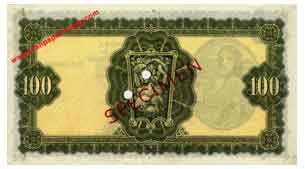
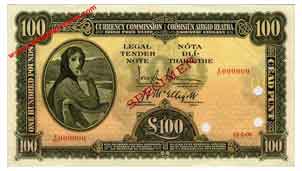
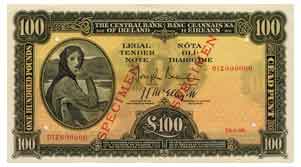
The highest denomination of Irish banknote to be introduced in the new Legal Tender Note series on 10 September 1928 was the new Irish 100 Pound note.
The Series A Lady Lavery Irish 100 note circulated for 67 years until it was replaced in 1995 by the Series C Irish 100 note. The Lavery 100 pound note was unusual among the Lavery series Irish banknotes in that it was in use in circulation for considerably longer than the other denominations of the series. The development of the Series B Irish 100 Pound note was cancelled in the late 1980s and the Series A Lavery 100 note remained in circulation as a result.
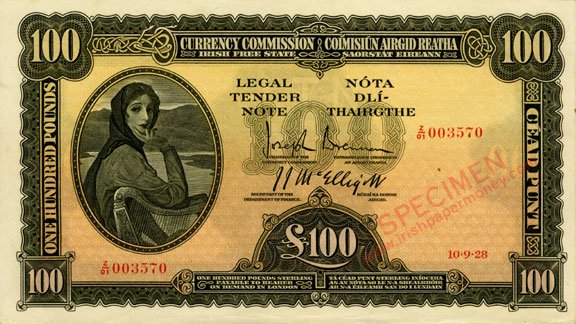
![]()
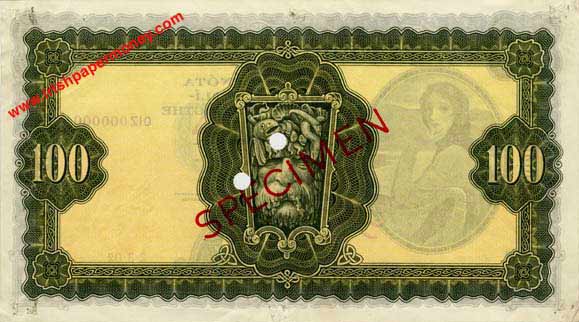
All of the joint stock banks had issued Irish 100 Pound notes, more or less since their foundation in the 1830s. Only one bank issued higher denomination Irish banknotes than 100 pounds. Bank of Ireland issued Irish 500 Pound notes steadily from 1869 until at least ca1900 [1. BOIAR]. The bank also issued other denominations between 100 Pounds and 500 pounds prior to 1869 [2. Hall, 1949].
The long-term issue of 100 Pound notes by the commercial banks had established the Irish 100 Pound note as a useful denomination. The currency Act (1927) allowed the Currency Commission to issue notes up to 100 pounds in value, and the Commission decided to continue the issue of Irish 100 Pound notes in 1928 with a modest initial printage of 4,000 Legal Tender Notes, all dated 10.9.28.
Apart from 10.9.28, with a printage of 4,000, most dates of the Lavery Irish 100 Pound note from 1943 to 1952 had a printage of 1,000 notes per date, apart from a few rare dates. Post-1952 dates had higher printages.
The highest price ever paid for a Lavery 100 pound note in auction was £32,000 plus fees for a 10.9.28 in AU grade, noonans.co.uk, 24 Feb 2022 [Lot 431].
The large version of the portrait of Lady Lavery was used on the Irish 100 Pound note, similar to the portrait used on the £10, £20 and £50 notes. On the 100 Pound note the portrait is 66 mm high.
Dimensions of the Series A Irish 100 pound note are approximately 203 x 114 mm. This was measured on a note dated 10.9.28, and on a note dated 11.11.59. Dimensions on different notes has been known to vary by a couple of millimetres.
The predominant colour of the Lavery Irish 100 note is a strong olive green, which is printed on a yellow and orange underprint.
A 'River mask' taken from the facade of the Custom House in Dublin was selected for the centrepiece of the reverse of the Legal tender 100 note.
For the 100 Pounds, the mask representing the River Erne was used. The river spirit is displaying its eel fisheries on its headdress [3. Moynihan 1975, p. 127].
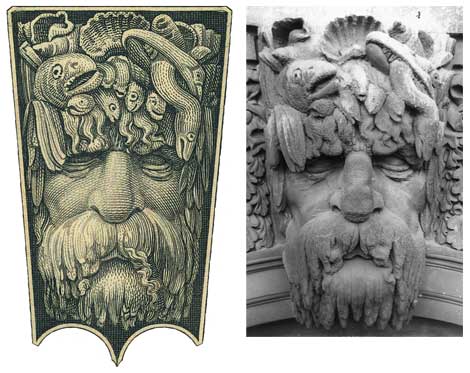
Left, the engraving of the Erne river mask, taken from the original (right) which adorns the facade above one of the windows on the front of the Custom House in Dublin. [4. Image at right ©Karl Whitney]
Irish 100 pound notes were printed regularly throughout the lifetime of the Series A Lavery Irish banknotes.
Apart from not being printed with a war code during World War 2, Irish 100 Pound notes were printed for each of the major design variations, and for each signature combination of the Series A Irish banknotes. This is not the case for the £20 and £50 notes, neither of which were printed for Type 2, Currency Commission Irish Free State with linear prefix.
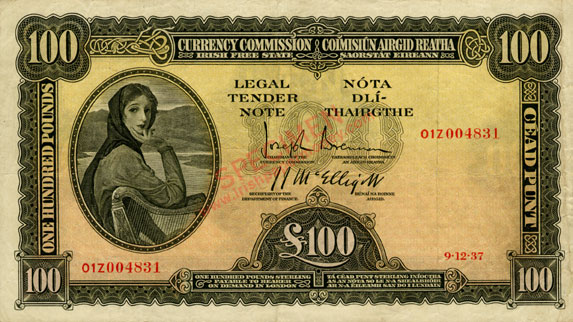
![]()
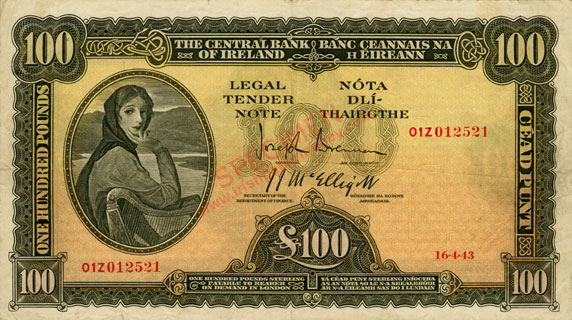
![]()
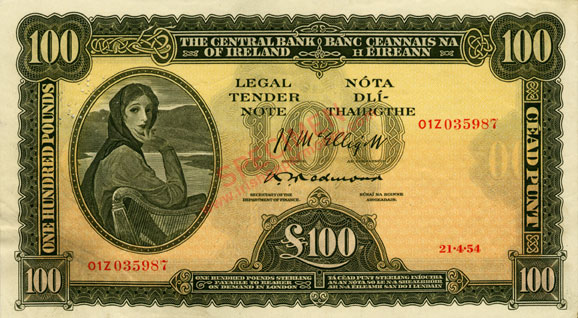
![]()

![]()
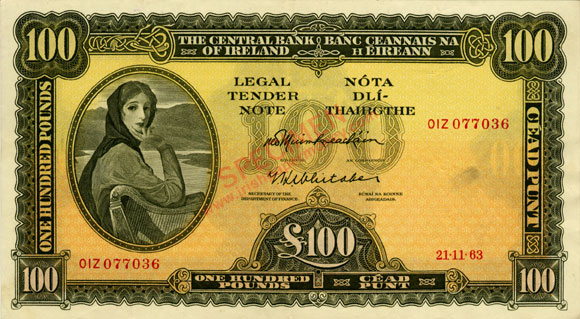
![]()
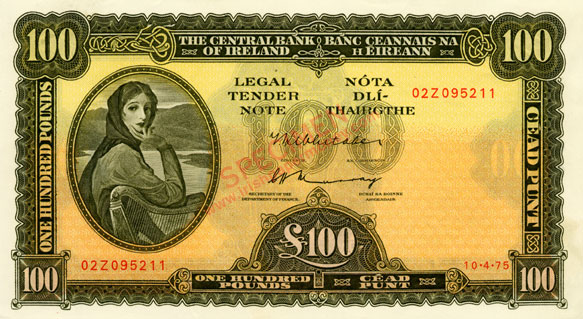
![]()
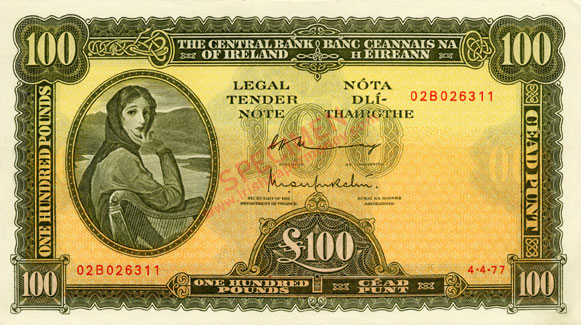
A major variation in the design of Series A Irish Legal tender Notes was the incorporation of a Special Identification Marking (SIM) 'War Code' into the design of some denominations during the World War 2 Emergency period. The War code is used on the lower five denominations, 10 shillings up to £20, Type 4 (1940-1942), and Type 5 (1943-1944).
Although Series A Irish 100 Pound notes were printed in 1943, a war code was not used on these notes. The same was the case for the Legal Tender 50 Pound notes printed in 1943.
The text, in English on the left and in Irish on the right at the bottom of each Irish 100 pound note indicates the link with Sterling at parity.
'One hundred Pounds Pounds Sterling payable to bearer on demand in London'
'Tá Céad Punt Sterling iníoctha as an nóta so le n-a shealbhóir ar n-a éilamh san do i Lundain'

1928–1959 Sterling Promise in the bottom panel of every Lady Lavery Irish 100 Pound note
The sterling promise text was removed from the design and replaced by the denomination in words on all Irish 100 pound notes printed from 1961 onwards.

1961–1977 Sterling promise replaced by denomination 'ONE HUNDRED POUNDS' 'CÉAD PUNT' in words
All Irish Legal Tender Notes were printed on watermarked paper. The watermark consisted of the Head of Eirin on the bottom right of on all denominations along with additional watermarks in the centre of each note which varied by denomination.
The centre watermarks varied on some denominations can be difficult to see. On 20, 50 and 100 Pound notes the centre watermark consists of the letters LTN, as illustrated below.
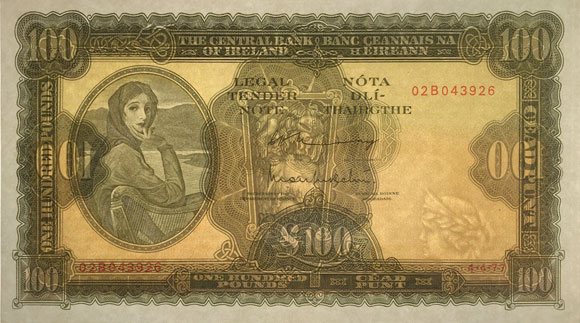
The watermark of the Head of Eirin can easily be seen on the lower right of this backlit illustration of a 1977 Lavery 100 Pound note. The letters 'LTN' in the centre are less easy to see
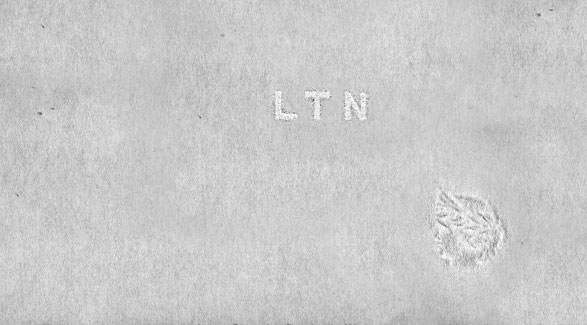
A mock-up of the watermarks on the Series A Irish 100 Pound Legal Tender Note
The Series A Lady Lavery 100 pound note designs incorporated tiny subtle security features on the face of each banknote, similar to other denominations of the series. These features took the form of small anomalies and extra symbols in the design of the note which differed on each denomination.
The Lavery 100 Pound notes contained two of these security marks, which are illustrated following.
Plate Letters on Lavery 100 Pound Notes
All Irish 100 pound notes printed by Waterlow and Sons Ltd. had a tiny plate letter printed on the face and reverse of each banknote. These Plate Tracer (PT) code letters marked the position of each note on the sheet of printed notes.
These PT codes were discontinued when De La Rue took over the printing of Irish banknotes. 1959 was the last year on which PT code letters appeared on the face and reverse of all Irish 100 pound notes.
The location of the PT codes on the Irish 100 pound note design is illustrated below.
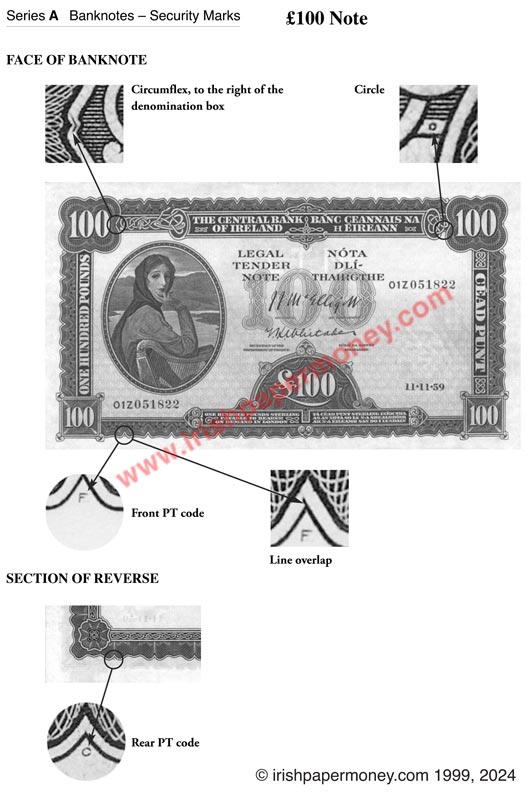
There are 43 dates for the Irish 100 Pound note, from 10.9.28 to 4.4.77. Within the range of £100 dates are several very rare dates by printage, including 20.12.37, the only £100 note date which has never been recorded, and 1.7.43 for which there has been one example recorded. Both of these Irish 100 Pound note dates have a printage of 300 notes [CBIAR].
There is one other rare date by printage for the 100 Pound note, 3.2.43, with two examples recorded. One example is in the National Museum of Ireland, and the other is in a private collection. 3.2.43 is the first date of issue on a Central Bank of Ireland 100 pound note.
Generally, dates in 1943 are scarcer, and more sought-after, than later dates.
References
1. Bank of Ireland Archives. BOIAR in the text.
2. Hall, F. G. (1949). 'The Bank of Ireland, 1783-1946'. Dublin: Hodges, Figgis and Company.
3. Moynihan, Dr. M. 'Currency and Central Banking in Ireland 1922–1960', Gill & Macmillan and The Central Bank of Ireland, 1975.
4. Image ©Karl Whitney. Riverine keystone head at the Custom House, Dublin, rendered in Portland stone by Edward Smyth, portraying one of the rivers of Ireland - in this case, the Blackwater. (Identified by Harold Leask). https://source.southdublinlibraries.ie/handle/10599/5553/simple-search?filterquery=Custom+House&filtername=subject&filtertype=equals [Last accessed 31.10.23]
5. CBIAR. Central Bank of Ireland Archive.
1 Pound Ploughman
5 Pounds Ploughman
10 Pounds Ploughman
20 Pounds Ploughman
50 Pounds Ploughman
100 Pounds Ploughman
Irish Ten Shilling Notes
1 Pound Note Lady Lavery
5 Pounds Lady Lavery
10 Pounds Lady Lavery
20 Pounds Lady Lavery
50 Pounds Lady Lavery
100 Pounds Lady Lavery
1 Pound Note, Queen Medb
5 Pound Note, John Scotus Eriugena
10 Pound Note, Jonathan Swift
20 Pound Note, W. B. Yeats
50 Pound Note, Turlough O'Carolan
100 Pound Note, Grace O'Malley
5 Pound Note, Sister Catherine McAuley
10 Pound Note, James Joyce
20 Pound Note, Daniel O'Connell
50 Pound Note, Douglas Hyde
100 Pound Note, Charles Stewart Parnell
Northen Ireland Polymer notes
Bank of Ireland Polymer Notes
Danske Bank Polymer Notes
Ulster Bank Polymer Notes
Special Sections and Articles
The Transition of Irish Currency, Irish banknotes 1918–1928
The Partition of Irish Currency, Irish banknotes 1928–1930
Banknote Design Evolution 1824 to 1916
Irish Three Pound Notes
Contemporary Forgeries of Early Irish Banknotes, ca1800-1930
Limerick Soviet Notes
Irish World War 2 Banknote Issues
Low Number Irish Banknotes
Irish Joint Stock Banks of Note Issue from 1783
Irish Legal Tender Note Specimens
Ploughman Scan Survey (PSS)
![]() Page under active revision, last update 04.01.25
Page under active revision, last update 04.01.25
